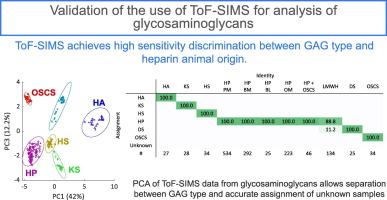Validation of the use of ToF-SIMS for analysis of glycosaminoglycans
IF 12.5
1区 化学
Q1 CHEMISTRY, APPLIED
引用次数: 0
Abstract
Glycosaminoglycans (GAGs) have a range of biological roles and are of particular interest for their pharmaceutical efficacy and their potential as biomarkers or drug targets. Heparin, used globally as an anticoagulant and an antithrombotic, is predominantly derived from porcine sources but bovine and ovine sources are increasingly being considered to reduce the substantial risk of reliance on a single animal species. However, high sensitivity chemical discrimination of heparins from different species is a significant analytical challenge. In this study ToF-SIMS analysis of GAGs is investigated as a methodology to achieve specific chemical discrimination between GAGs of different types and heparins from different animal sources. The ToF-SIMS data acquisition is relatively fast (≈1 min per sample) and requires minimal sample amounts (75 pg of sample analysed). Multivariate analysis (MVA) models enabled high selectivity between GAG type and animal source of heparin, and for the high sensitivity detection of GAG-contaminants within porcine derived heparin. Contaminants are detected down to 0.001 wt%, with the exception of ovine derived heparin where differences could be detected to 0.01 wt%. Assessments of specificity, precision, robustness and quantification limits are conducted to validate the approach for heparin analysis.

ToF-SIMS用于糖胺聚糖分析的验证
糖胺聚糖(GAGs)具有广泛的生物学作用,因其药物功效和作为生物标志物或药物靶点的潜力而受到特别关注。肝素在全球范围内用作抗凝血剂和抗血栓剂,主要来源于猪,但人们越来越多地认为牛和羊的来源可以减少依赖单一动物物种的重大风险。然而,不同种类肝素的高灵敏度化学鉴别是一个重大的分析挑战。在这项研究中,ToF-SIMS分析作为一种方法来研究不同类型的GAGs和不同动物来源的肝素之间的特异性化学区分。ToF-SIMS数据采集相对较快(每个样品≈1分钟),并且需要最少的样本量(分析75 pg样品)。多变量分析(multi - Multivariate analysis, MVA)模型对肝素的GAG类型和动物来源具有高选择性,对猪源肝素中GAG污染物的检测具有高灵敏度。污染物可检测到0.001 wt%,但羊源肝素的差异可检测到0.01 wt%。对特异性、精密度、稳健性和定量限制进行评估,以验证肝素分析方法的有效性。
本文章由计算机程序翻译,如有差异,请以英文原文为准。
求助全文
约1分钟内获得全文
求助全文
来源期刊

Carbohydrate Polymers
化学-高分子科学
CiteScore
22.40
自引率
8.00%
发文量
1286
审稿时长
47 days
期刊介绍:
Carbohydrate Polymers stands as a prominent journal in the glycoscience field, dedicated to exploring and harnessing the potential of polysaccharides with applications spanning bioenergy, bioplastics, biomaterials, biorefining, chemistry, drug delivery, food, health, nanotechnology, packaging, paper, pharmaceuticals, medicine, oil recovery, textiles, tissue engineering, wood, and various aspects of glycoscience.
The journal emphasizes the central role of well-characterized carbohydrate polymers, highlighting their significance as the primary focus rather than a peripheral topic. Each paper must prominently feature at least one named carbohydrate polymer, evident in both citation and title, with a commitment to innovative research that advances scientific knowledge.
 求助内容:
求助内容: 应助结果提醒方式:
应助结果提醒方式:


